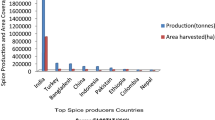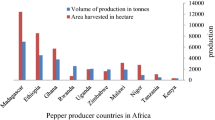Abstract
Cumin is a flowering plant and the second Ethiopian export spice crop next to ginger. The area coverage, as well as the production of white cumin, is increasing year to year. However, there is a growing gap between white cumin demand and supply in Ethiopia due to its low production and productivity of white cumin. Therefore, this study was aimed to investigate factors affecting the technical inefficiency of white cumin production among smallholder producers in Northwestern Ethiopia. A Semi-structured questionnaire was used to collect the primary data from 228 white cumin producers, who were selected by using a systematic random sampling technique. Moreover, a combination of data analysis methods such as descriptive statistics and the stochastic Cobb–Douglas production frontier model was used to analyze the collected data. The empirical result of the study showed that the mean technical efficiency of white cumin production was 81%. This implies that white cumin producers can boost white cumin output by 19% using the existing level of inputs and technology. The maximum likelihood estimates of the stochastic production model revealed that land, Nitrogen-Phosphate and Sulphate, and urea were statistically and positively affected the production level of white cumin. The positive effect indicates that the lack of these inputs would hamper the production of white cumin. Moreover, the maximum likelihood estimate of the stochastic frontier model coupled with the inefficiency parameters indicated that the age of household head, tropical livestock unit, land fragmentation, and membership of cooperatives were found to be statistically and negatively influence the level of technical inefficiency of white cumin producers, whereas family size, distance to the main road and credit access were found to be statistically and positively influence the level of technical inefficiency of white cumin producers. Hence, the study suggested that the government should strengthen farm cooperatives and construct roads near the residence of producers to improve their efficiency level. Moreover, the district experts should arrange an experience-sharing (which is a proxy variable for age) program to improve the efficiency level of less efficient producers by adopting the best practice of relatively efficient producers.

Source: Own develo** using Shape file (2021)


Similar content being viewed by others
Availability of data and materials
The authors want to declare that they can submit the data at any time based on publisher’s request. The datasets used and/or analyzed during the current study was available from the authors on reasonable request.
Abbreviations
- ADEA:
-
Association for the Development of Education for Africa
- BoFED:
-
Bureau of Finance and Economic Development
- CC:
-
Contingency coefficient
- CGAO:
-
Central Gondar zone Agriculture Office
- EEA:
-
Ethiopian Economic Asssociation
- FAO:
-
Food and Agriculture Organization
- GDP:
-
Gross Domestic Product
- MoA:
-
Ministry of Agriculture
- LR:
-
Log-likelihood Ratio
- NPC:
-
National Planning Commission
- SSCC:
-
Spice Sector Strategy Coordinating Committee
- TE:
-
Technical Efficiency
- VIF:
-
Variance inflation factor
References
Abebe, G. G.: Off-farm income and technical efficiency of smallholder producers in Ethiopia (2014)
Adea, A. F. T. D. O. E. F. A.: Ethiopia Country Report For The 2014 Ministerial Conference On Youth Employment, Abidjan, Côte d’Ivoire, 21–23 July (2014)
Abate, T.M., Dessie, A.B., Mekie, T.M.: Technical efficiency of smallholder producers in red pepper production in North Gondar zone Amhara regional state Ethiopia. J. Econ. Struct. 8, 18 (2019)
Abebe, D.: Technical efficiency of onion production under irrigation: the case of Kalu Woreda of South Wollo (Doctoral dissertation, MSc Thesis, Haramaya University, Haramaya, Ethiopia) (2009)
Ahmed, M.H., Lemma, Z., Endrias, G.: Technical efficiency of maize producing producers in Arsi Negelle, Central Rift valley of Ethiopia: Stochastic frontier approach. Poljoprivreda i Sumarstvo 60, 157 (2014)
Alemayehu, M., Tessafa, F., Bizuayehu, S. & Ayele, B.: Amhara Region Horticulture Development Strategy (2015–2019). Agro-Big, Bahir Dar, Ethiopia. URL: https://www. agrobig. org/documents/7.1 _Amhara_Region_H orticulture_Development_Strategy_2015–2019. pdf. Accessed on January, 20, 2018 (2015)
Alemu, B.A., Nuppenau, E., Boland, H.: Technical efficiency of farming systems across agro-ecological zones in Ethiopia: an application of stochastic frontier analysis. Agri. J. 4, 202–207 (2009)
Attokaran, M.: Natural food flavors and colorants. John Wiley & Sons (2017)
Ayele, A., Haj, J., Tegegne, B.: Technical efficiency of wheat production by smallholder producers in Soro district of Hadiya Zone, Southern Ethiopia. East African J. Sci. 13(2), 113–120 (2019)
Bekele, A. R.: Technical efficiency variation for smallholder irrigated maize producers: a case study of tibila surface water irrigation scheme. Mekelle University (2013)
Belete, A.S.: Analysis of technical efficiency in maize production in Guji Zone: stochastic frontier model. Agriculture & Food Security 9(1), 1–15 (2020)
Beshir, H.: Technical efficiency measurement and their differential in wheat production (2016)
Bofed, B. O. F. A. E. D.: Amhara national regional state population projection based on the 2007 census (2009)
Cgao, C. G. Z. A. O.: Annual report on area coverage and production of major crops during 2018/2019 production season (2019)
Chipeta, M., Emana, B. & Chanyalew, D.: Ethiopia’s Agriculture Sector Policy and Investment Framework (2010–2020) External Mid-term Review. Secretariat of the Government of Ethiopia, Development Partners Sector (2015)
Cochran, W. G. 1977. Sampling techniques-3
Coelli, T.J.: A guide to FRONTIER version 4.1: a computer program for stochastic frontier production and cost function estimation (Vol. 7, pp. 1–33). CEPA Working papers (1996)
Degefa, K., Jaleta, M., Legesse, B.: Economic efficiency of smallholder producers in maize production in Bako Tibe district, Ethiopia. Dev. Country Stud. 7, 80–86 (2017)
Dessie, A.B., Abate, T.M., Adane, B.T., Tesfa, T., Getu, S.: Estimation of technical efficiency of black cumin (Nigella sativa L.) farming in northwest Ethiopia: a stochastic frontier approach. J. Econ. Struct. 9, 1–14 (2020)
EEA, E. E. A.: Annual Report on Ethiopian Economy. Addis Ababa, Ethiopia (2012)
FAO, F. A. A. O.: Ethiopia Country Highlights on Irrigation Market Brief. UNFAO, Rome, Italy. Prepared under Food and Agricultural Organization of United Nations (UNFAO)/International Finance Corporation (IFC) cooperation (2015)
Fikadu-Lebeta, W., Diriba-Shiferaw, G. & Mulualem-Azene, M.: The Need of Integrated Nutrient Management for Coriander (Coriandrum sativum L.) Production (2019)
Geta, E., Bogale, A., Kassa, B., Elias, E.: Productivity and efficiency analysis of smallholder maize producers in Southern Ethiopia. J. Hum. Ecol. 41, 67–75 (2013)
Haile, B.T.: Determinants of technical allocative and economic efficiencies among onion producing producers in irrigated agriculture: empirical evidence from Kobo district Amhara region Ethiopia. Afr. J. Agri. Res. 10, 2180–2189 (2015)
INTERNET Accessed December 24, 2019. Royal Enclosure Gondar, Ethiopia FAMOUS GONDAR CASTLES OF ETHIOPIA, LOCATED IN FASIL GHEBBI, a 7 ha royal enclosure: (https://www.nationalparks-worldwide.com/eaf/ethiopia/gondar/gondar.html).
Kitila, G.M., Alemu, B.A.: Analysis of technical efficiency of small holder maize growing producers of Horo Guduru Wollega zone, Ethiopia: a stochastic frontier approach. Sci, Technol Arts Res. J. 3, 204–212 (2014)
Lemma, Z., Zinabu, T.: Analysis of technical efficiency of teff producer producers in Raya Kobo District, Amhara National Regional State. Haramaya University, Ethiopia (2016)
MOA, M. O. A.: Report on area coverage and production of major crops, Addis Ababa, Ethiopia (2016)
Moa, M. O. A.: Report on area coverage and production of major crops, Addis Ababa, Ethiopia (2013)
NPC, N. P. C.: Ethiopian second five year (2015/162019/20) Growth and transformation plan, Addis Ababa, Ethiopia (2015)
Newut, T.: Analysis of economic efficiency of cumin (Cuminumcyminum) In North Achefer District, Amhara National Regional State, Ethiopia. St. Mary's University (2017)
Rahman, A., Akbar, D., Bhattarai, S., Thomson, M., Trotter, T. and Timilsina, S.: Market analysis of cumin seed. Online: Central Queensland University. (2020)
SSCC, S. S. S. C. C.: Spice Sub-Sector STRATEGY for ETHIOPIA, ACP Agricultural Commodities Programme. International Trade Centre (ITC), Division of Country Programmes (DCP), Export Strategy (2010)
Sisay, D., Jema, H., Goshu, D., Abdi, K.: Agricultural technology adoption, crop diversification and efficiency of maize-dominated farming System in Jimma Zone. Haramaya University Ethiopia, South-Western Ethiopia (2016)
Sisay, D.: Agricultural technology adoption, crop diversification and efficiency of maize-dominated smallholder farming system in Jimma Zone, Southwestern Ethiopia. Haramaya University, Ethiopia (2016)
Teklemariam, T. M.: The impact of international potato center’s nutrition project on smallholder producers’ income and adoption of improved potato varieties: Tigray region, Northern Ethiopia. Mekelle University (2014)
Tesfaw, Z., Zemedu, L., Tegegn, B.: Technical efficiency of Teff producer producers in Raya Kobo district, Amhara National Regional State Ethiopia. Cogent Food Agri. 7(1), 1865594 (2021)
The case of smallholder producers in South Wollo. IJEBF, 4, 1–16.
Wassie, S. B.: Technical efficiency of major crops in Ethiopia: stochastic frontier model. (2014)
Wossen, T.: Determination of optimum rates of nitrogen and phosphorus fertilization for white cumin (Trachyspermum ammi (I) sprague) in Takusa Woreda of North Gondar Zone. Int. J. Sci. Res. Publ. 8, 460–463 (2017)
Yami, M., Solomon, T., Begna, B., Fufa, F., Alemu, T., Alemu, D.: Source of technical inefficiency of smallholder wheat producers in selected waterlogged areas of Ethiopia: a translog production function approach. Afr. J. Agric. Res 8, 3930–3940 (2013)
Acknowledgements
The authors would like to Gratitude University of Gondar for covering all the study costs. Moreover, we thank the data respondents, enumerators and district experts for their valuable response during data collection process.
Funding
The University of Gondar was provided financial support to complete this research successfully. That means all authors received research grant form University of Gondar. Therefore, all cost incurred for this research was covered by this grant.
Author information
Authors and Affiliations
Contributions
All authors read and approved the final manuscript.
Corresponding author
Ethics declarations
Conflict of interest
All authors have received research grant from University of Gondar to accomplish this research for collecting research data. The authors declare that they have no competing interests.
Ethical approval and consent to participate
Ethical clearance letters were collected from University of Gondar research and community service directorate and Central Gondar zone of face to care for both the study participants and the researchers. During survey, of facial letters were written for each kebele /villages/ informed verbal permission was obtained from each client, and confidentiality was maintained by giving codes for each respondent rather than recording their name. Study participants were informed that clients have a full right to discontinue or refuse to participate in the study. Hence, all participants throughout the research, including survey households, enumerators, the supervisors and key informants were fully informed of the objectives of the study. They were approached friendly in free moods until then do this research.
Consent for publication
Not applicable
Additional information
Publisher's Note
Springer Nature remains neutral with regard to jurisdictional claims in published maps and institutional affiliations.
Rights and permissions
About this article
Cite this article
Abate, T.M., Dessie, A.B., Adane, B.T. et al. Analysis of resource use efficiency for white cumin production among smallholder farmers empirical evidence from Northwestern Ethiopia: a stochastic frontier approach. Lett Spat Resour Sci 15, 213–235 (2022). https://doi.org/10.1007/s12076-022-00299-4
Received:
Accepted:
Published:
Issue Date:
DOI: https://doi.org/10.1007/s12076-022-00299-4




